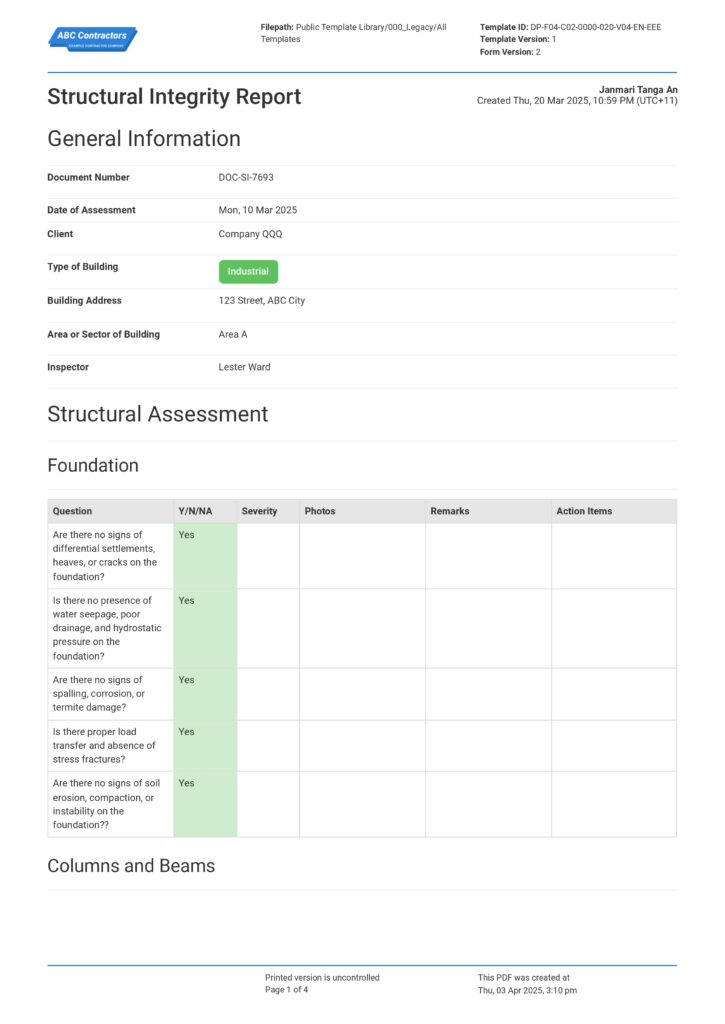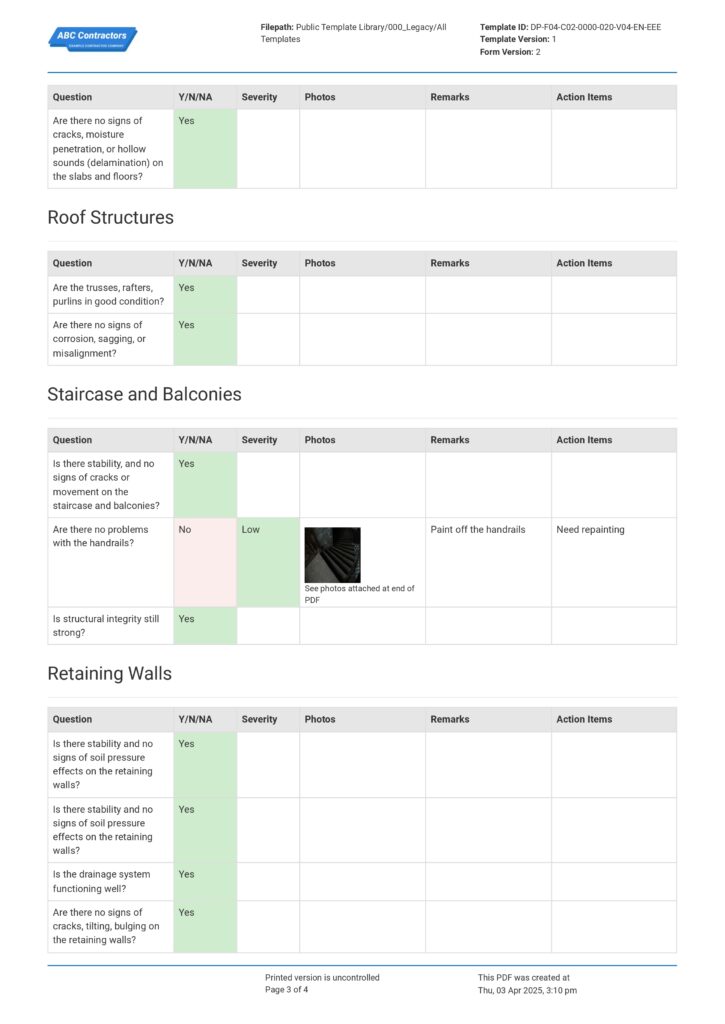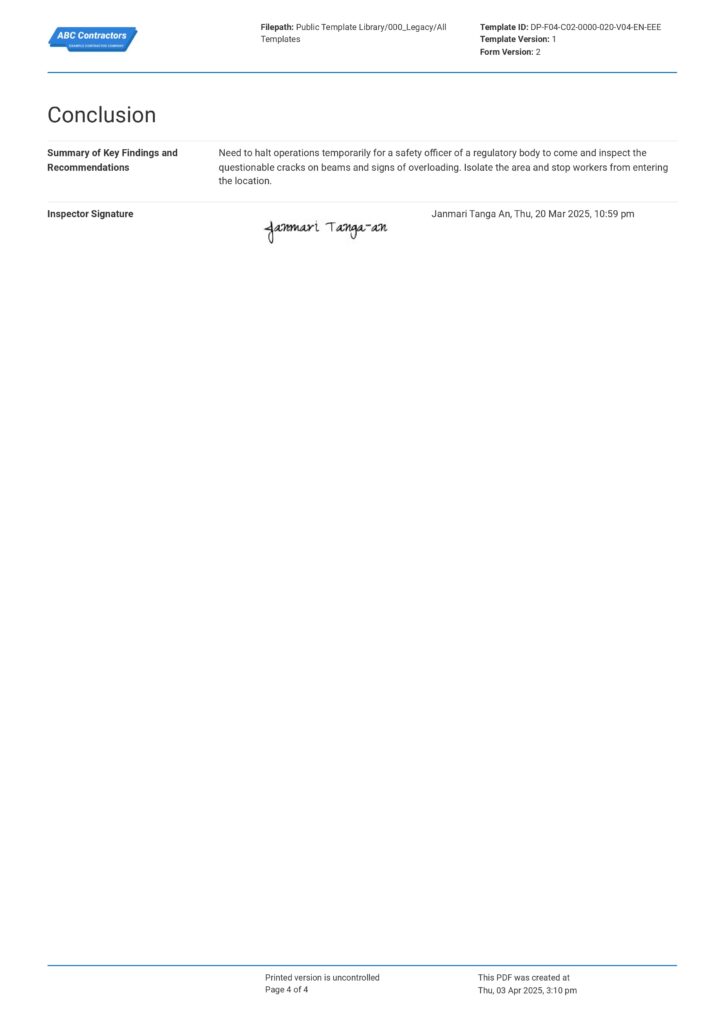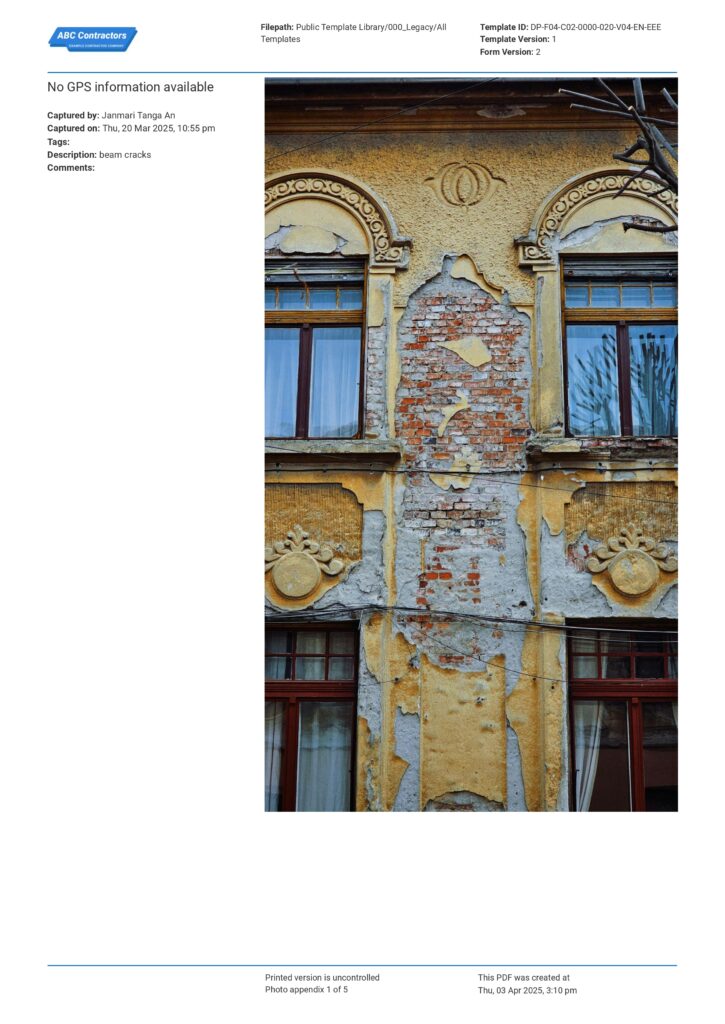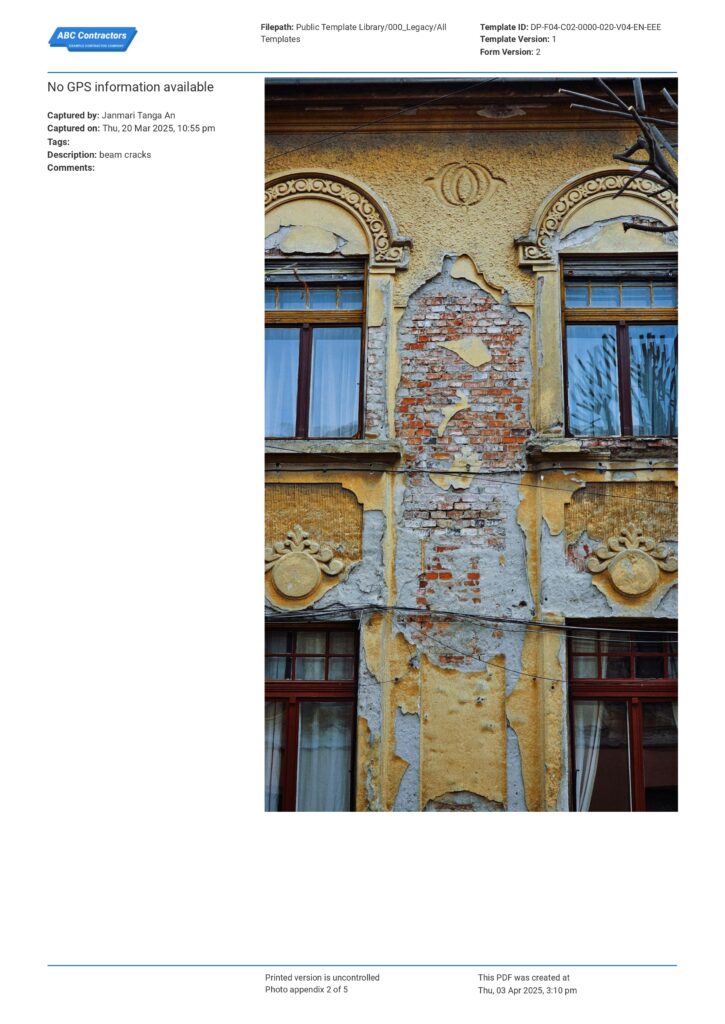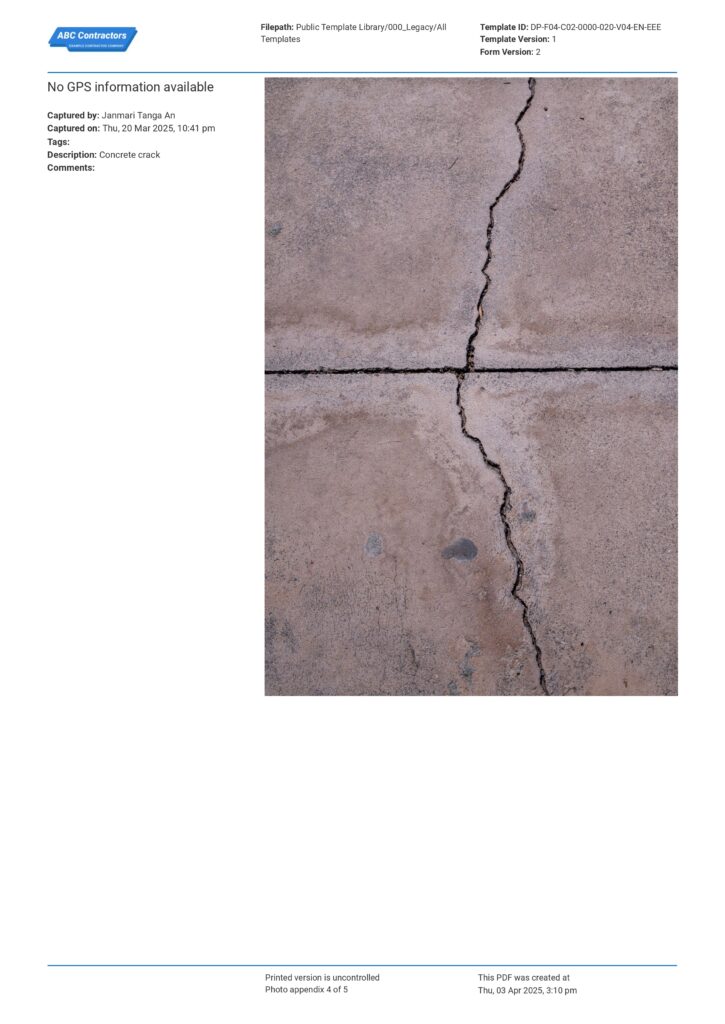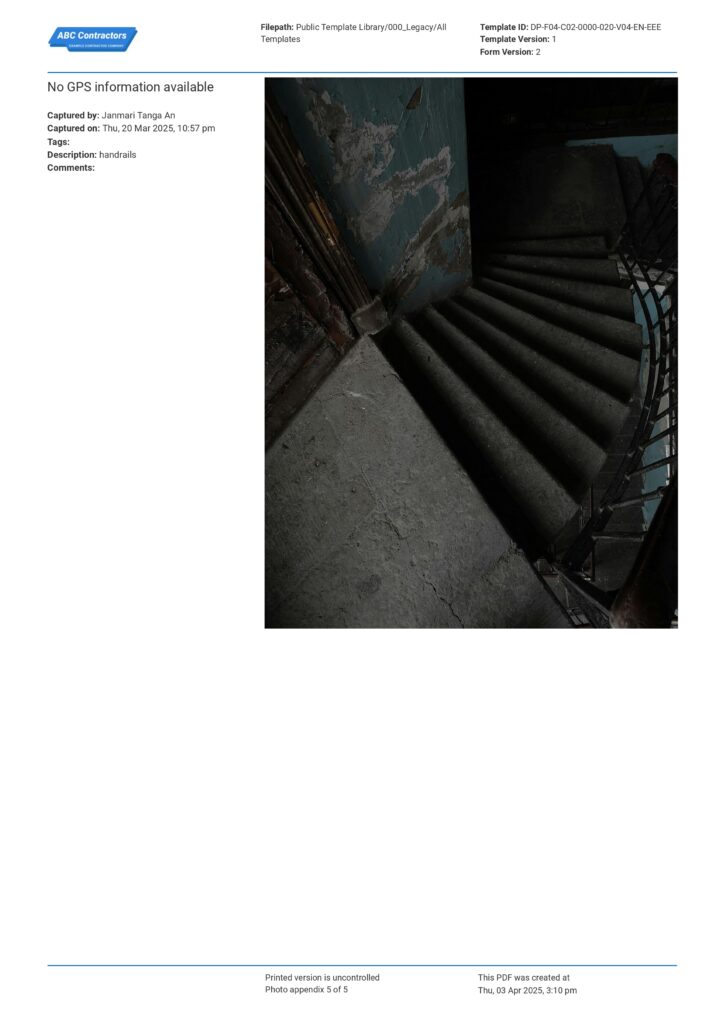Structural Integrity Report Template
Start with a free 30-day trial. No credit card required.
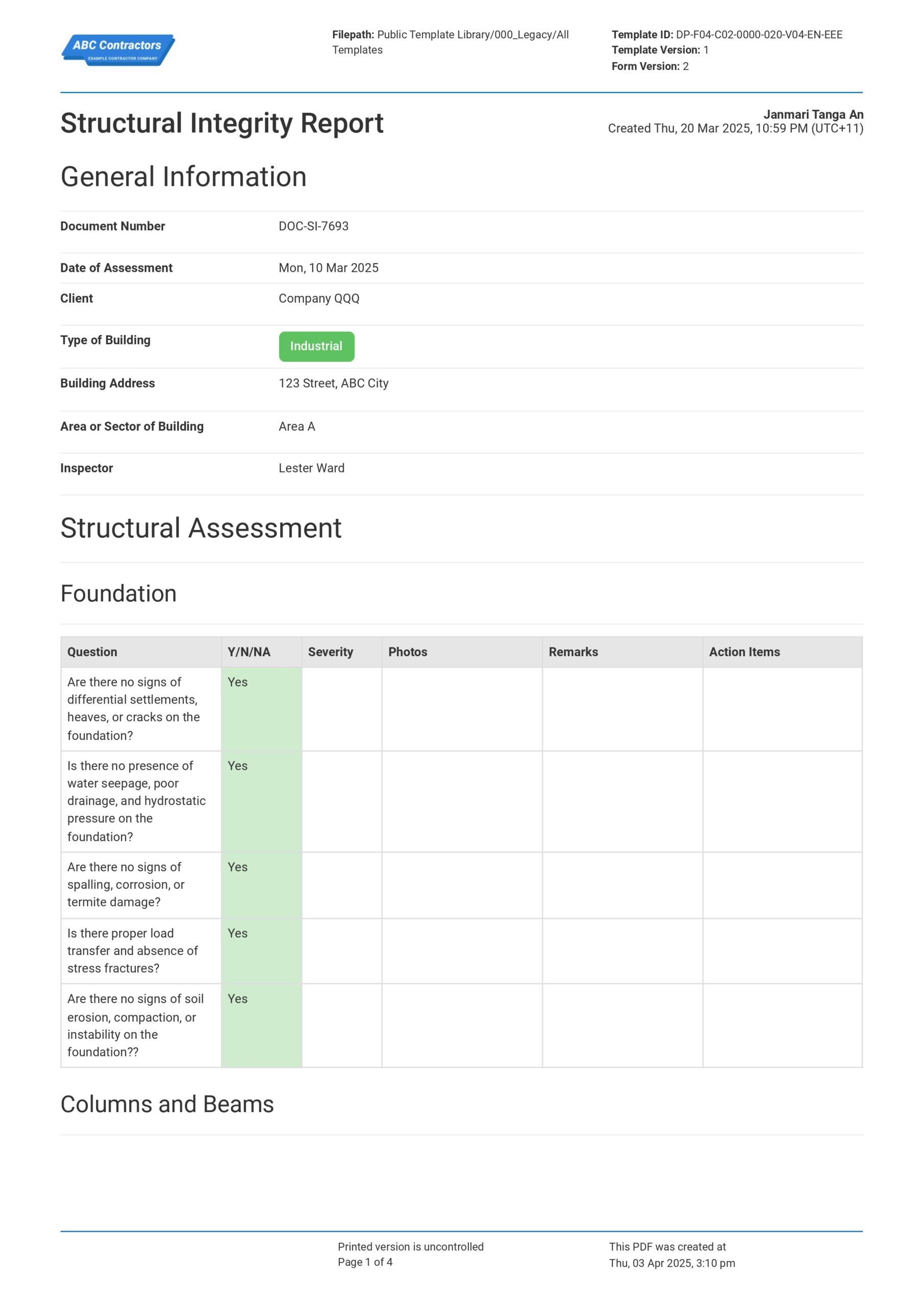
~200 employees
~20 employees
~25,000 employees
~40 employees
~10,000 employees
~1,500 employees
~35,000 employees
What is a Structural Integrity Report?
When we talk about structural integrity, we are referring to the capacity of a structure to resist the load that it was designed to bear without incurring catastrophic collapse or excessive deformation. Strength, stability, and resistance to disturbances from the environment, such as wind, seismic activity, and temperature swings, are all included in this category of considerations. To avoid catastrophic failures and to ensure that structures continue to be safe and functioning throughout their lifetimes, it is vital to ensure that structural integrity is maintained.
Compare this Structural Integrity Report format to manual Word, Excel and PDF forms
Use this structural integrity report template for free.
What is the importance of a Structural Integrity Report?
To understand the importance of the structural integrity report, we must first look at its purpose, because from there we can gauge how it is beneficial to businesses.
Safety
When we talk about the soundness of a building, we often link it to safety. It is common understanding that a structurally sound building is a very safe building. In engineering terms, it is part of the design to integrate a factor of safety. It is a safety measure to place an additional leeway above the maximum requirement to prevent design failures. Having said this, part of the purpose of a structural integrity report is also associated with checking the safety of the building. Structural components that show signs of damage can potentially compromise the soundness of the building, which can be dangerous for the inhabitants or pedestrians in the building.
Regulatory Compliance
The process of abiding by relevant laws, rules, policies and procedures, standards, and other guidelines published by governing authorities is known as regulatory compliance. Generally, there are always rules and regulations for the building's structural integrity, depending on the area. Regularly inspecting the building is one of these obligations. As a prerequisite for inspection, a structural integrity report may serve as reliable proof in regulatory audits. The state of the key structural elements, which are linked to the building's durability, is often shown in these reports. That being said, the report must be comprehensive and easy to read, as shown by the digital form provided here, to be considered a thorough examination of the structure.
Cost savings
When you are doing structural integrity studies, it may assist you in identifying minor flaws or damages that can be handled immediately. This eliminates the danger of the issue developing into a large problem, which might possibly lead to an increase in the cost of repair and the building being deemed unsafe. If there is a significant issue with the building's structural integrity, it will also have an impact on the daily operations of the facility. Due to the fact that significant repairs need to be carried out and the structure's safety is jeopardised, this might possibly put an end to all enterprises that have been created within the building.
How should a Structural Integrity Report be completed?
See below for the different methods of doing structural integrity reports:
Structural Integrity Reporting Through Visual Inspections
Visual inspection is a technique that uses the human eye to detect defects, ensuring the structural soundness of a structural component. It is a technique that does not entail the use of measuring equipment and does not involve any intrusive procedures. Visual inspection is helpful when detecting early signs of deterioration and failure. This can then be addressed early to prevent the damage from becoming something catastrophic. The digital structural integrity we have shared here is a form for visual inspection.
Non-Destructive Testing
Testing that does not cause damage is referred to as non-destructive testing (NDT). Inspectors are able to analyse and gather data on a material, system, or component without permanently modifying it via the use of a variety of inspection techniques. In checking structural integrity assessments, a lot of different NDT methods are used. Here are popular methods of NDT that is used to check structural integrity:
- Ultrasonic Testing
- Radiographic Testing
- Magnetic Particle Testing
- Ground Penetrating Radar
- Eddy Current Testing
Load Testing
During load testing, a structure is put through a series of controlled loads in order to determine how it reacts when subjected to situations that are representative of the real world. In contrast to simulations or theoretical calculations, physical load testing makes it possible to get solid information on the behaviour of a building when it is exposed to forces from the outside.
Structural Health Monitoring
The process of determining the condition of health or integrity of a structure by using real-time and event-response data is referred to as Structural Health Monitoring (SHM). The objective of SHM is finding damage before it reaches a critical condition , which aims to increase both safety and dependability. To make this possible, specifically designed sensors are incorporated into the structure to read data like temperature, stress, and strain in order to detect possible faults.
Have you gone digital with your field reporting?
When filing a structural integrity report, a digital platform may be more effective and record-friendly. We will provide you reasons why this story is true.
- There are a number of different structures and buildings out there. Creating a form manually can be a tedious process. You have to make different formats depending on what kind of building and what area of the building needs to be checked. Typing all of these manually would require you to allot a huge chunk of hours. With this digital template here, you can create custom forms with a drag-and-drop builder or use and edit an existing template in the template library. This user-friendly interface can help with hours allocated for template creation to be greatly reduced.
- When doing an inspection manually, the paper you are holding can be subject to a lot of factors, which can compromise the data contained in that report. The handwriting of the assessor, the cleanliness of the paper, the completeness of the form, and the thoroughness of the data being uploaded into the computer may all have a substantial impact on the required data when using the pen and paper method. This digital form removes the chance of data illegibility, keeps things tidy, requires the user to fill out the necessary areas, and allows the user to upload the completed form straight to the computer, removing the chance of human mistake.
- You may add photos to the report using the template that is shown to you on this page. When doing this by hand, you must first upload the image to the computer and then print it. Employees may shoot as many photos and videos as they want using the template shown above, and each one is instantly synced to the database for public access. Additionally, the files are logically organised into folders, making it possible to access them at any moment with only a few clicks.
.
Other popular templates you can use and customise for free

Snag list
Don't let snags get in the way of project completion.

Structural damage report
Prevent structural damage from turning into a disaster using this report structure.

Damage Assessment Report
Use this damage assessment report to properly document and assess damage in any event, including disasters.
This Report was generated with Dashpivot software
You can easily create a comprehensive structural integrity report using a digital form to help you get direct results from the visual inspection.
- Access, edit, and complete field reports from any device—mobile, tablet, or computer.
- Print, download, or send your structural reports as perfectly formatted PDF documents with your company logo.
- Store your reports securely online, where they can be searched and found in seconds
- Invite internal and external parties to see, edit, and sign off on reports online.
Sitemate builds best-in-class software tools for built world companies.
